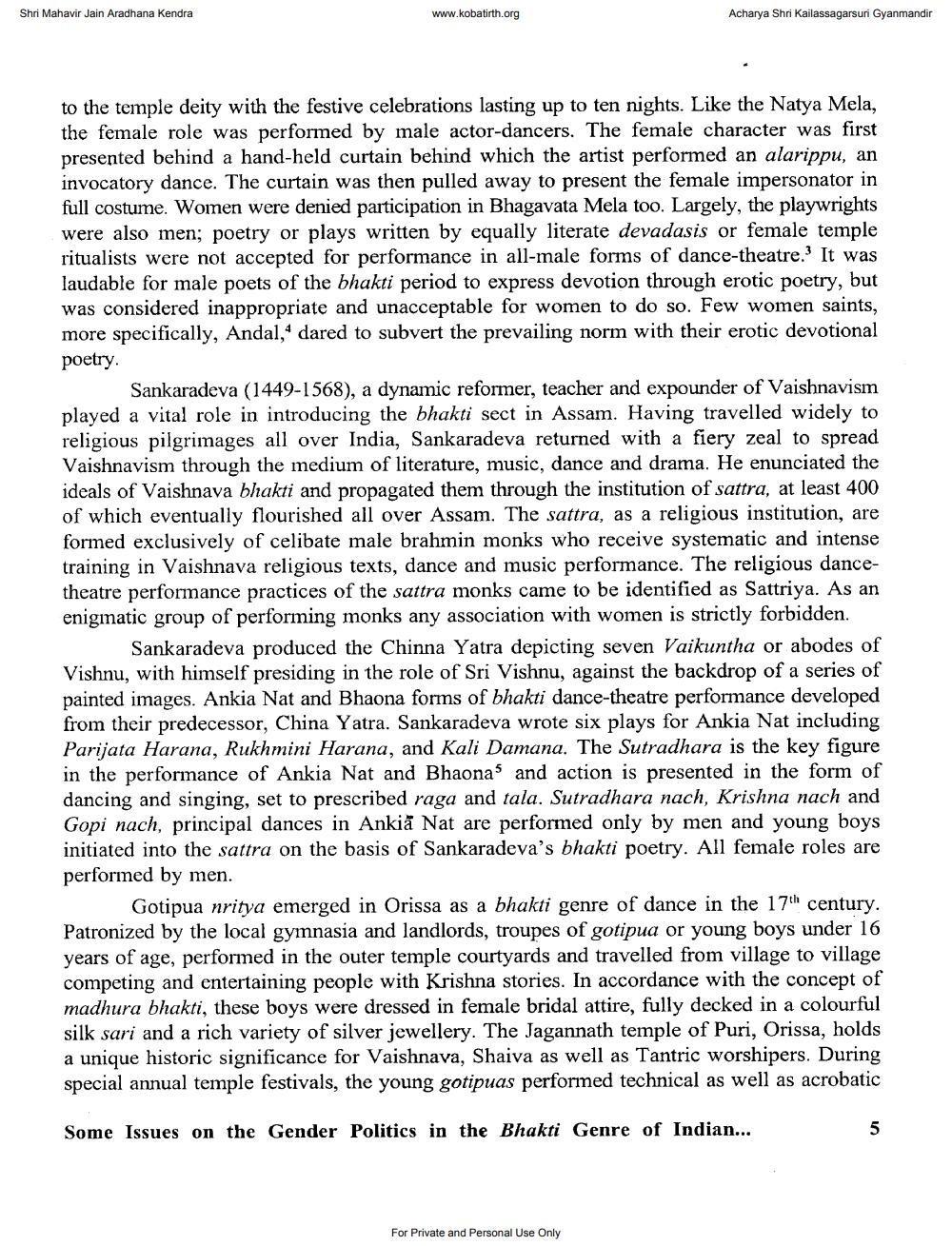________________
Shri Mahavir Jain Aradhana Kendra
www.kobatirth.org
Acharya Shri Kailassagarsuri Gyanmandir
to the temple deity with the festive celebrations lasting up to ten nights. Like the Natya Mela, the female role was performed by male actor-dancers. The female character was first presented behind a hand-held curtain behind which the artist performed an alarippu, an invocatory dance. The curtain was then pulled away to present the female impersonator in full costume. Women were denied participation in Bhagavata Mela too. Largely, the playwrights were also men; poetry or plays written by equally literate devadasis or female temple ritualists were not accepted for performance in all-male forms of dance-theatre. It was laudable for male poets of the bhakti period to express devotion through erotic poetry, but was considered inappropriate and unacceptable for women to do so. Few women saints, more specifically, Andal," dared to subvert the prevailing norm with their erotic devotional poetry.
Sankaradeva (1449-1568), a dynamic reformer, teacher and expounder of Vaishnavism played a vital role in introducing the bhakti sect in Assam. Having travelled widely to religious pilgrimages all over India, Sankaradeva returned with a fiery zeal to spread Vaishnavism through the medium of literature, music, dance and drama. He enunciated the ideals of Vaishnava bhakti and propagated them through the institution of sattra, at least 400 of which eventually flourished all over Assam. The sattra, as a religious institution, are formed exclusively of celibate male brahmin monks who receive systematic and intense training in Vaishnava religious texts, dance and music performance. The religious dancetheatre performance practices of the sattra monks came to be identified as Sattriya. As an enigmatic group of performing monks any association with women is strictly forbidden.
Sankaradeva produced the Chinna Yatra depicting seven Vaikuntha or abodes of Vishnu, with himself presiding in the role of Sri Vishnu, against the backdrop of a series of painted images. Ankia Nat and Bhaona forms of bhakti dance-theatre performance developed from their predecessor, China Yatra. Sankaradeva wrote six plays for Ankia Nat including Parijata Harana, Rukhmini Harana, and Kali Damana. The Sutradhara is the key figure in the performance of Ankia Nat and Bhaonas and action is presented in the form of dancing and singing, set to prescribed raga and tala. Sutradhara nach, Krishna nach and Gopi nach, principal dances in Ankiä Nat are performed only by men and young boys initiated into the sattra on the basis of Sankaradeva's bhakti poetry. All female roles are performed by men.
Gotipua nritya emerged in Orissa as a bhakti genre of dance in the 17th century. Patronized by the local gymnasia and landlords, troupes of gotipua or young boys under 16 years of age, performed in the outer temple courtyards and travelled from village to village competing and entertaining people with Krishna stories. In accordance with the concept of madhura bhakti, these boys were dressed in female bridal attire, fully decked in a colourful silk sari and a rich variety of silver jewellery. The Jagannath temple of Puri, Orissa, holds. a unique historic significance for Vaishnava, Shaiva as well as Tantric worshipers. During special annual temple festivals, the young gotipuas performed technical as well as acrobatic.
Some Issues on the Gender Politics in the Bhakti Genre of Indian...
For Private and Personal Use Only
5




